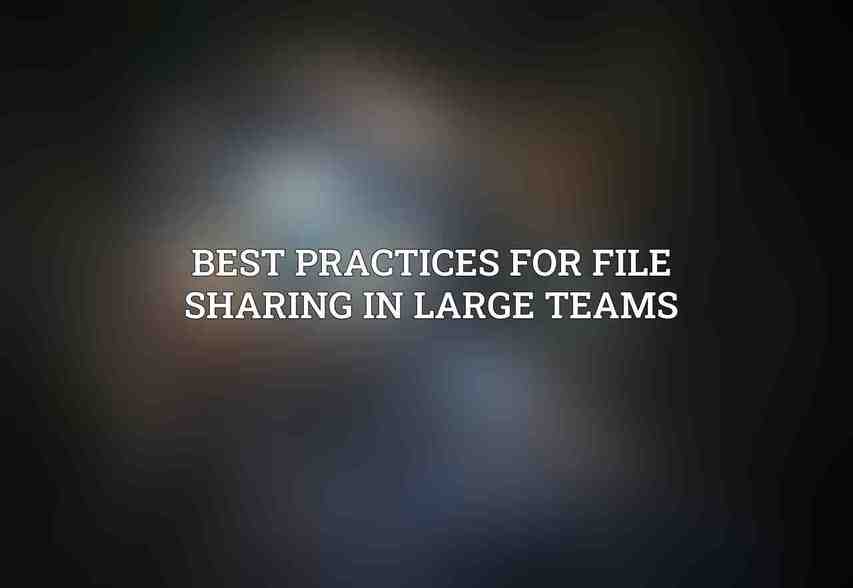Effective file sharing is essential for large teams to collaborate efficiently and securely. the need for seamless sharing of documents, multimedia files, and data within a team or organization is paramount for productivity and success. However, with the increase in remote work and distributed teams, the challenges of managing large volumes of files in a collaborative environment have become more complex than ever before.
Factors to Consider When Choosing File Sharing Tools
When selecting file sharing tools for large teams, several crucial factors need to be taken into account to ensure a smooth workflow and optimal collaboration experience.
A. File size limits
Managing large files efficiently is crucial for teams working with data-intensive projects such as CAD designs, high-resolution videos, or datasets. Understanding the file size limits imposed by different file sharing tools is essential to prevent any limitations in sharing critical files.
Overview of common file size restrictions:Below is a brief overview of some common file size limits imposed by popular file sharing platforms:
| File Sharing Platform | Maximum File Size Limit |
|---|---|
| Google Drive | 5 TB per file |
| Microsoft OneDrive | 100 GB per file |
| Dropbox Business | 50 GB per file |
| Box | 100 GB per file |
| Citrix Content Collaboration | 50 GB per file |
B. User management
Effective user management within file sharing platforms is essential for maintaining data security and access control. Features like role-based access controls (RBAC) and group management play a crucial role in defining permissions and collaboration capabilities for team members.
Role-based access controls (RBAC):RBAC allows administrators to assign specific roles to users, defining their access rights and permissions within the file sharing platform. This ensures that sensitive data is only accessible to authorized personnel.
C. Security features
Security is a top priority when selecting file sharing tools for large teams, particularly when handling confidential or sensitive information. Encryption protocols, compliance certifications like HIPAA and GDPR, and robust data protection mechanisms are key factors to consider.
Compliance requirements and certifications:Adhering to industry-specific regulations and certifications is critical for ensuring the highest standards of data protection and compliance within the organization.
D. Integration capabilities
Seamless integration with existing applications and workflows is essential for enhancing productivity and streamlining collaboration processes. File sharing tools that offer robust API availability for custom integrations can significantly enhance the overall user experience.
Integration with existing applications:Integration with tools like Microsoft Office or Google Workspace enables users to work seamlessly across different platforms, enhancing productivity and collaboration efficiency.
E. Collaboration tools
Effective collaboration features such as real-time editing, document co-authoring, version control, and conflict resolution capabilities are instrumental in promoting teamwork and ensuring accurate document management within large teams.
Version control and conflict resolution:Version control tools enable users to track changes, revert to previous versions, and resolve conflicts efficiently, ensuring data integrity and accuracy.
Top File Sharing Platforms for Large Teams

Several file sharing platforms cater specifically to the needs of large teams, offering a range of features tailored to enhance collaboration and productivity.
A. Google Drive
Google Drive is a popular file sharing platform known for its comprehensive suite of productivity tools and seamless collaboration features.
Key Features of Google Drive:
– File size limit: 5 TB per file
– User management: Role-based permissions, group sharing
– Security: 256-bit encryption, access control lists
– Integration: Google Workspace suite compatibility, 3rd-party app integrations
– Collaboration tools: Real-time editing, document history, versioning
B. Microsoft OneDrive
Microsoft OneDrive is an integrated file sharing and storage platform that seamlessly integrates with the Microsoft Office suite.
Key Features of Microsoft OneDrive:
– File size limit: 100 GB per file
– User management: Sharepoint-based permissions, guest access
– Security: Azure Active Directory authentication, data encryption
– Integration: Microsoft Office suite integration, OneDrive for Business option
– Collaboration tools: Real-time co-authoring, document comparison, versioning
C. Dropbox Business
Dropbox Business is a widely used file sharing platform that offers easy file synchronization and collaboration features for teams.
Key Features of Dropbox Business:
– File size limit: 50 GB per file
– User management: Team folder permissions, member groups
– Security: End-to-end encryption, data recovery options
– Integration: Dropbox API, third-party app integrations
– Collaboration tools: File requests, document previews, version history
D. Box
Box is a secure cloud content management platform that caters to the needs of enterprises and large teams requiring robust data protection and collaboration features.
Key Features of Box:
– File size limit: 100 GB per file
– User management: Flexible permissions, external collaboration
– Security: Advanced encryption options, compliance certifications (e.g., FedRAMP)
– Integration: 3rd-party app integrations, Box API
– Collaboration tools: Document collaboration, versioning, real-time chat
E. Citrix Content Collaboration
Citrix Content Collaboration is a comprehensive file sharing platform designed to enhance team collaboration and content workflows.
Key Features of Citrix Content Collaboration:
– File size limit: 50 GB per file Find more on Best Tools for Real-Time File Sharing and Collaboration
– User management: SharePoint integration, group and role-based permissions
– Security: Secure file sharing, data loss prevention (DLP)
– Integration: Citrix Workspace suite, 3rd-party app integrations
– Collaboration tools: Document workflows, content search, real-time annotations
Best Practices for File Sharing in Large Teams

Implementing best practices for file sharing in large teams is crucial for maintaining data integrity, security, and streamlined collaboration workflows.
A. Establish clear file sharing guidelines
Establishing clear guidelines for file sharing, access permissions, and data management ensures that team members understand their roles and responsibilities in maintaining data security.
B. Use a centralized repository for team files
Centralizing team files in a secure and organized repository improves accessibility, searchability, and version control, ensuring that the latest versions of documents are readily available to all team members.
C. Organize files using a hierarchical structure
Organizing files in a hierarchical structure based on projects, departments, or categories simplifies navigation and ensures that team members can easily locate and access the files they need.
D. Set up version control and backup systems
Implementing version control mechanisms and backup systems safeguards against data loss, enables tracking of changes, and ensures that previous versions of documents can be restored if needed.
E. Implement user training and support
Providing training sessions and ongoing support to team members on using file sharing tools effectively promotes adoption, enhances workflow efficiency, and reduces the risk of errors or data breaches.
Choosing the right file sharing tools for large teams involves considering a multitude of factors ranging from file size limits and security features to collaboration tools and integration capabilities. By selecting a platform that aligns with the specific needs of the team and implementing best practices for file sharing, organizations can streamline collaboration, enhance productivity, and ensure data security in this dynamic work environment. Making an informed decision based on the outlined criteria will enable large teams to optimize their file sharing processes and drive success in their collaborative endeavors.
Frequently Asked Questions
Why is it important to choose the right file sharing tools for large teams?
Choosing the right file sharing tools for large teams is crucial for ensuring efficient collaboration, seamless communication, and secure data sharing among team members. Read more on Enhancing Remote Work Efficiency through Advanced File Sharing Tools
What factors should be considered when selecting file sharing tools for large teams?
Factors to consider when selecting file sharing tools for large teams include ease of use, security features, collaboration capabilities, scalability, integration with existing systems, and cost.
How can file sharing tools help improve productivity and efficiency for large teams?
File sharing tools can help improve productivity and efficiency for large teams by streamlining communication, enabling real-time collaboration, centralizing document storage, automating workflows, and facilitating remote work.
What are some popular file sharing tools that are suitable for large teams?
Popular file sharing tools that are suitable for large teams include Google Drive, Dropbox Business, Microsoft OneDrive for Business, Box, and Slack.
How can I ensure the security of sensitive data when using file sharing tools for large teams?
To ensure the security of sensitive data when using file sharing tools for large teams, you should choose tools that offer end-to-end encryption, access control features, audit trails, data loss prevention, and compliance with industry standards and regulations. Find more on Top 10 Best File Sharing Tools for 2024 Reviewed

